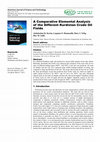Papers by abdulsalam karim
Petroleum Science and Technology
Journal of Zankoy Sulaimani - Part A, 1999
Journal of Zankoy Sulaimani - Part A, 1997

two types of crude oil from Hassira and Khurmala crude oil distilled into narrow fractions. The r... more two types of crude oil from Hassira and Khurmala crude oil distilled into narrow fractions. The ranges of these narrow fractions are 10 C, starting from IBP to 350 °C. Petroleum streams produced from distillation of crude oil such as gasoline, kerosene, diesel fuel, fuel oil, etc. are complex mixtures of large numbers of hydrocarbon components, such fractions are generally characterized in terms of small petroleum cuts, or pseudocomponents, which are identified primarily by their boiling point and specific gravity due to their true boiling point curve (TBP), based on these two properties empirical correlations were derived to predict other components physical properties required for the process calculations. TBP distillation data and density of whole crude oil are used to perform the basic characterization and to obtain the product distribution of the crudes (using Aspen HYSHYS software).

two types of crude oil from Hassira and Khurmala crude oil distilled into narrow fractions. The r... more two types of crude oil from Hassira and Khurmala crude oil distilled into narrow fractions. The ranges of these narrow fractions are 10 C, starting from IBP to 350 °C. Petroleum streams produced from distillation of crude oil such as gasoline, kerosene, diesel fuel, fuel oil, etc. are complex mixtures of large numbers of hydrocarbon components, such fractions are generally characterized in terms of small petroleum cuts, or pseudocomponents, which are identified primarily by their boiling point and specific gravity due to their true boiling point curve (TBP), based on these two properties empirical correlations were derived to predict other components physical properties required for the process calculations. TBP distillation data and density of whole crude oil are used to perform the basic characterization and to obtain the product distribution of the crudes (using Aspen HYSHYS software).
Three different boiling range fractions of gas oil were produced from Kurdistan Taq-Taq crude oil... more Three different boiling range fractions of gas oil were produced from Kurdistan Taq-Taq crude oil. Their percentage yield were estimated to be (F1= 34.12, F2= 15.6,F3= 25). Full physical and chemical analysis for all fractions were achieved and compared to Iraqi marketing specifications, then the structural group analysis for the three fractions were determined using n-d-M method.

Five different Kurdistan crude oils produced in various fields (namely Swara tuka, Miran, Khurmal... more Five different Kurdistan crude oils produced in various fields (namely Swara tuka, Miran, Khurmala, shiwashok and Tawki) were analyzed and evaluated. From each crude oil two types of different boiling ranges (300oC+ and 350oC+) fuel oils were produced. All crude oil samples and fuel oils were evaluated using ASTM standard methods of testing, and compared to Iraqi specification of fuel oils. The results showed that all fuel oils are within the Iraqi specification except that produced from Tawki crude oil, which are higher in sulfur content (4.28%w/w for 300oC+ and 5.0 %w/w for 350oC+ fuel oils). Elemental analysis done for all crude oil samples and fuel oils, showed the highest Vanadium content in Tawki crude oil with (10 ppm) and also the highest Vanadium content in fuel oils produced from Tawki crude oil with (36 ppm for 300oC+ and 40 ppm for 350oC+ fuel oils), other metal content of all crude oils and fuel oils are below these value.
P Abstract— Gas condensate from khor-Mhor field and Naphtha cuts from Taq-Taq crude oil and Khorm... more P Abstract— Gas condensate from khor-Mhor field and Naphtha cuts from Taq-Taq crude oil and Khormala crude oil have been fully analyzed and evaluated using ASTM standard test methods. Two Types of additives and pyrolysis gasoline have been blended with naphtha samples in different volumetric ratios. Octane number of each blend has been measured using three different octane analyzers. Index Terms—Additive , ASTM , Gasoline , Gas condensate , Naphtha, Octane analyzer , Octane number . —————————— ——————————
Petroleum Science and Technology
Petroleum Science and Technology
Petroleum Science and Technology
Journal of Zankoy Sulaimani - Part A
The Journal of Scientific and Engineering Research
Effects of different types of EPDM (ethylene-propylene-dine monomer) improvers in manufacturing o... more Effects of different types of EPDM (ethylene-propylene-dine monomer) improvers in manufacturing of engine oil grades (SAE-30, SAE-40, and SAE-50) on thermal properties of these oils have been investigated. The additives type (KEP270, DE3071, K 4802, DCR3 and PA 6205) were used to prepare grades (SAE-30, SAE-40 and SAE-50). The solutions were characterized by determination specific gravity, viscosity index, flash point and pour point. The effect of temperature (from40 oC to 100 oC) and concentration (from 0.5 to 3.5 w/v %) have been also studied.

Five different Kurdistan crude oils produced in various fields (namely Swara tuka, Miran, Khurmal... more Five different Kurdistan crude oils produced in various fields (namely Swara tuka, Miran, Khurmala, shiwashok and Tawki) were analyzed and evaluated. From each crude oil two types of different boiling ranges (300ºC+ and 350ºC+) fuel oils were produced. All crude oil samples and fuel oils were evaluated using ASTM standard methods of testing, and compared to Iraqi specification of fuel oils. The results showed that all fuel oils are within the Iraqi specification except that produced from Tawki crude oil, which are higher in sulfur content (4.28%w/w for 300ºC+ and 5.0 %w/w for 350ºC+ fuel oils). Elemental analysis done for all crude oil samples and fuel oils, showed the highest Vanadium content in Tawki crude oil with (10 ppm) and also the highest Vanadium content in fuel oils produced from Tawki crude oil with (36 ppm for 300ºC+ and 40 ppm for 350ºC+ fuel oils), other metal content of all crude oils and fuel oils are below these value.
Arabian Journal of Chemistry, 2013
Effects of different types of EPDM (ethylene-propylene-dine monomer) improvers in manufacturing o... more Effects of different types of EPDM (ethylene-propylene-dine monomer) improvers in manufacturing of engine oil grades (SAE-30, SAE-40, and SAE-50) on thermal properties of these oils have been investigated. The additives type (KEP270, DE3071, K 4802, DCR3 and PA 6205) were used to prepare grades (SAE-30, SAE-40 and SAE-50). The solutions were characterized by determination specific gravity, viscosity index, flash point and pour point. The effect of temperature (from40 oC to 100 oC) and concentration (from 0.5 to 3.5 w/v %) have been also studied.
Effects of different types of EPDM (ethylene-propylene-dine monomer) improvers in manufacturing o... more Effects of different types of EPDM (ethylene-propylene-dine monomer) improvers in manufacturing of engine oil grades (SAE-30, SAE-40, and SAE-50) on thermal properties of these oils have been investigated. The additives type (KEP270, DE3071, K 4802, DCR3 and PA 6205) were used to prepare grades (SAE-30, SAE-40 and SAE-50). The solutions were characterized by determination specific gravity, viscosity index, flash point and pour point. The effect of temperature (from40 oC to 100 oC) and concentration (from 0.5 to 3.5 w/v %) have been also studied.









Uploads
Papers by abdulsalam karim